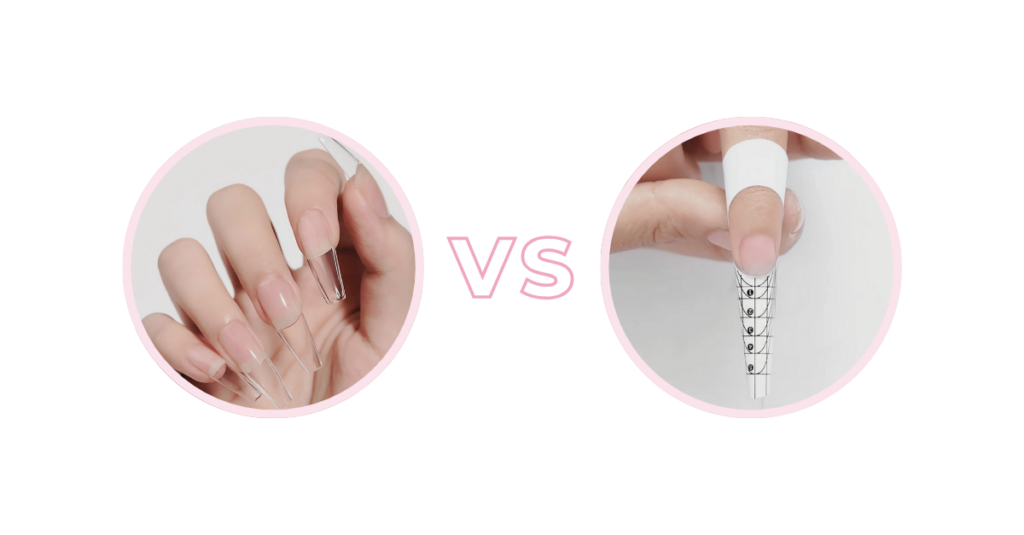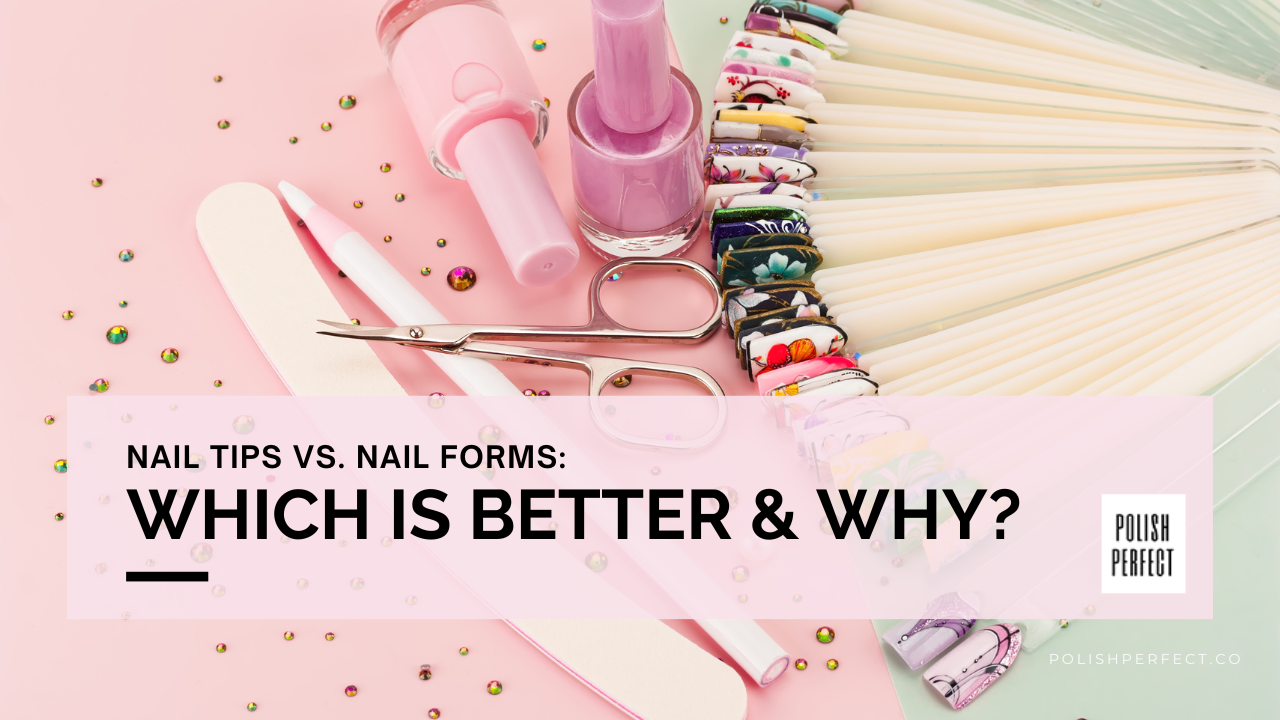Ever wondered the best way to flaunt those dreamy, sexy, extended nails?
In the world of nail enhancements, the nail tips vs nail forms debate often pops up.
While nail tips offer a quick, uniform appeal, nail forms promise customization and durability.
Curious about which reigns supreme for most scenarios? Let’s dive in and compare to find out which shines the brightest for you!
Acrylic Nail Tips Vs. Nail Forms: What Are They?

If you’re a nail technician, you know that there are a variety of techniques and tools to create stunning nail extensions.
Two popular options are acrylic nail tips and nail forms. But what exactly are they?
What Are Nail Tips?
Nail tips are essentially fake nails that are made from molded plastic. They come in various shapes, sizes, and designs to cater to different nail preferences.
Nail tips are applied by gluing them onto the natural nail plate. Some nail tips fully cover the entire nail plate, while others only cover a portion of it.
Nail Tip Pros
Nail tips offer several advantages that make them a popular choice among nail technicians:
1. Versatility: With nail tips, you have a wide range of shapes, sizes, and designs to choose from, allowing you to create customized looks for your clients.
2. Speed: Applying nail tips is generally faster than using nail forms, making them a time-saving option for busy nail techs.
3. Affordability: Nail tips are often more affordable than nail forms, making them a budget-friendly choice for both technicians and clients.
Nail Tip Cons
Despite their popularity, nail tips do have a few downsides to consider:
1. Weaker Structure: Nail tips are not as structurally strong as nail forms, which means they may be more prone to breakage or damage.
2. Limited Customization: While nail tips offer a range of shapes and designs, they may not provide the same level of customization as nail forms.
3. Potential Damage: The adhesive used to attach nail tips can weaken the natural nail if not applied and removed properly.
How To Apply Nail Tips
1. Sizing the Nail Tip
Once the nail tip is selected, the next step is to ensure that each tip is sized properly to fit each natural nail. If this isn’t done sufficiently, then you risk the nail tip breaking, falling off completely, or even damaging the natural nail.
2. Thinning, Filing, and Shaping
A good nail expert makes sure the nail tip fits just right on every side of your nail.
Sometimes, they need to change the nail tip size to match yours perfectly. They do this by using a file or buffer to make the tip thinner before sticking it on.
Making the tip thinner means it can bend a bit, which is good because it puts less stress on your nail. This way, your cool new nail is less likely to break or get hurt!
3. Applying Acrylic Nail Enhancement
Finally, once the nail tips are sufficiently filed, thinned, and shaped, it is time to apply the final layer of acrylic nail enhancement.
If you have never had nail tips before, then it is normal for them to feel heavy at first as you adjust to them, however, they shouldn’t hurt.
With that being said, you should never see pockets of glue peeking out from under or around the nail tip or feel pressure after the nail tip is glued on.
If either of these scenarios occurs, then alert your nail tech immediately.
How Long Do Acrylic Tips Last
Acrylic nail tips can last for up to two weeks, but it depends on several factors. If you take care of your acrylics properly and do not remove them too soon, they should stay intact longer than a few days or even months.
However, if worn improperly such as by using harsh nail polish remover with acetone which will dry out the natural oils in the skin around your nails then this may cause more breakage and chips over time- so be careful!
If applied carefully enough at home without any mistakes that could compromise their longevity (like applying topcoat before letting fingernails air-dry), acrylic nail tips can last approximately 2 weeks.
The type of work that you have can also affect its durability, but what majorly affects is the quality of your nails. Again, there are many factors that determine the life of an acrylic tip, but its average lifespan is 2 weeks.
What Are Nail Forms?

Nail forms are basically large stickers that are applied to the nail plate. Nail forms can be disposable or reusable. Most nail tech professionals use disposable nail forms as they are more convenient and sanitary than reusable nail forms.
Additionally, nail forms also come in two different types: horseshoe and CND performance. This image shows the two different types of nail forms; the gold is the horseshoe, and the silver is the CND performance nail form.
No one nail form is better than the other; it simply comes down to the nail tech’s preference and comfort levels.
Nail Form Pros
Nail forms offer several advantages that make them a popular choice for experienced nail technicians:
1. Customization: Nail forms allow for more freedom and creativity when it comes to shaping and designing the extension. You have full control over the length, shape, and curvature.
2. Stronger Structure: Nail forms create a more durable and long-lasting extension compared to nail tips.
3. Natural Look: Nail forms provide a more natural-looking result since the extension is sculpted directly onto the natural nail.
Nail Form Cons
While nail forms have their fair share of benefits, they also come with a few drawbacks:
1. Learning Curve: Applying nail forms requires practice and skill. It may take some time to master the technique and achieve consistent results.
2. Time-Consuming: Compared to nail tips, using nail forms can be more time-consuming, especially for nail techs who are not yet proficient in the process.
3. Cost: Nail forms can be more expensive than nail tips.
How To Apply Nail Forms
1. Apply the Nail Form. The nail form is slipped under the edge of the natural nail and is then wrapped around the finger.
The nail form should hug the nail and finger snugly, but not too tight. This is the trickiest part about using a nail form. The placement must be perfect and should avoid gaps under the edge.
Although this takes some practice, once a nail tech masters this, using nail forms becomes faster and easier than using nail tips as no filing or thinning of the nail tip is needed.
2. Blend the Seam. Using nail forms is cool because you don’t have to make the nail tip super thin. All you do is file a bit to make the edge of the nail form blend in nicely.
3. Apply Acrylic Nail Enhancement. Finally, the nail tech applies the enhancement chemicals along the nail form to create a longer nail.
Not only are nail forms easier and faster, but there also isn’t any pressure on the nail plate; rather the acrylic nail enhancement molds to the natural shape of the nail rather than filing the natural nail to conform to the contour of the nail tip.
Many nail tech professionals and customers believe that nail forms are safer, more comfortable, and have more of a natural look than nail tips.
What Acrylic Nail Forms Are Recommended
When it comes to nail forms, it is recommended to go for the ones you can throw away after use.
They can be shaped to fit any nail. The top ones are made of paper and shiny foil; this helps make a cool curve without squeezing too hard.
When picking a form, make sure it sticks well and doesn’t easily tear like regular paper. Watch out for plastic ones, as they can break and stain your nails.
But, some clear plastic ones are strong and won’t color your fancy gel nails. So, they can be a good choice, too!
Watch this video about nail tips vs nail forms to see their application process and learn so tips on using them.
Acrylic Nail Tips Vs. Nail Forms: What Are Their Differences

When it comes to creating flawless and stunning acrylic nails, two methods reign supreme: acrylic nail tips and nail forms.
We already know so much about them from the previous sections.
Now, let’s compare them head-to-head in different aspects to which one suits your clients:
1. Application Process
When it comes to the application process, acrylic nail tips are generally easier and quicker to apply. The pre-shaped tips eliminate the need for sculpting and shaping, saving time for both the technician and the client.
Nail forms, on the other hand, require more skill and precision to create the desired shape and length. The technician needs to sculpt the nail extension from scratch, which can be time-consuming, especially for beginners.
2. Customization Options
One advantage of nail forms is the ability to create custom shapes and lengths. Since the form acts as a mold, technicians can sculpt the extension to match the client’s natural nail shape or create unique designs.
Acrylic nail tips, on the other hand, come in predetermined shapes and sizes, limiting the customization options. However, with the wide variety of pre-shaped tips available, technicians can still achieve a stunning look for their clients.
3. Strength and Durability
Both acrylic nail tips and nail forms can create strong and durable nail extensions. However, acrylic nail tips tend to be slightly stronger due to the additional layer of acrylic applied over the tip. This makes them less prone to breakage and lifting.
Nail forms, on the other hand, rely solely on the strength of the applied acrylic or gel. While they can still create durable extensions, they may be more susceptible to damage if not applied correctly.
4. Natural Nail Health
When it comes to preserving the health of the natural nail, nail forms have the upper hand. Since they are applied directly onto the natural nail, there is minimal to no contact with adhesive or glue. This means less damage and the potential for nail dehydration.
Acrylic nail tips, on the other hand, require the use of adhesive to attach the tip to the nail, which can weaken the natural nail over time if not properly maintained.
5. Skill Level and Experience
Acrylic nail tips are generally considered more beginner-friendly compared to nail forms. The pre-shaped tips make it easier for technicians to achieve a consistent and professional look, even with limited experience.
Nail forms, on the other hand, require a higher level of skill and precision to create seamless and natural-looking extensions. They may take more practice to master, especially when it comes to sculpting and shaping.
The Verdict: Nail Tips or Nail Forms?
So, which one should you choose? Well, it ultimately depends on your skill level, client preferences, and the look you’re trying to achieve.
Nail tips are a great option for beginners or those who value speed and affordability. On the other hand, nail forms offer more customization and durability for experienced nail techs who want to create stunning, long-lasting extensions.
In the end, both nail tips and nail forms have their place in the nail industry. It’s all about finding the right tool for the job and delivering beautiful, flawless nails to your clients.
Now that you have the lowdown on nail tips vs. nail forms, it’s time to put your skills to the test and decide which technique works best for you.
Happy nail sculpting, my fellow technicians!
Was this article helpful? We would love to hear your thoughts on nail tips and nail form. So, feel free to comment in the box below.



